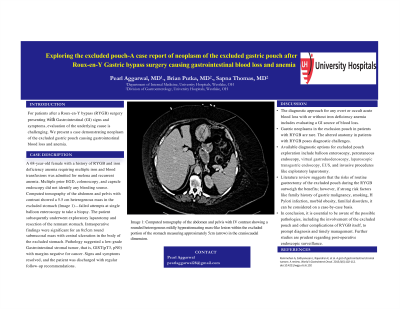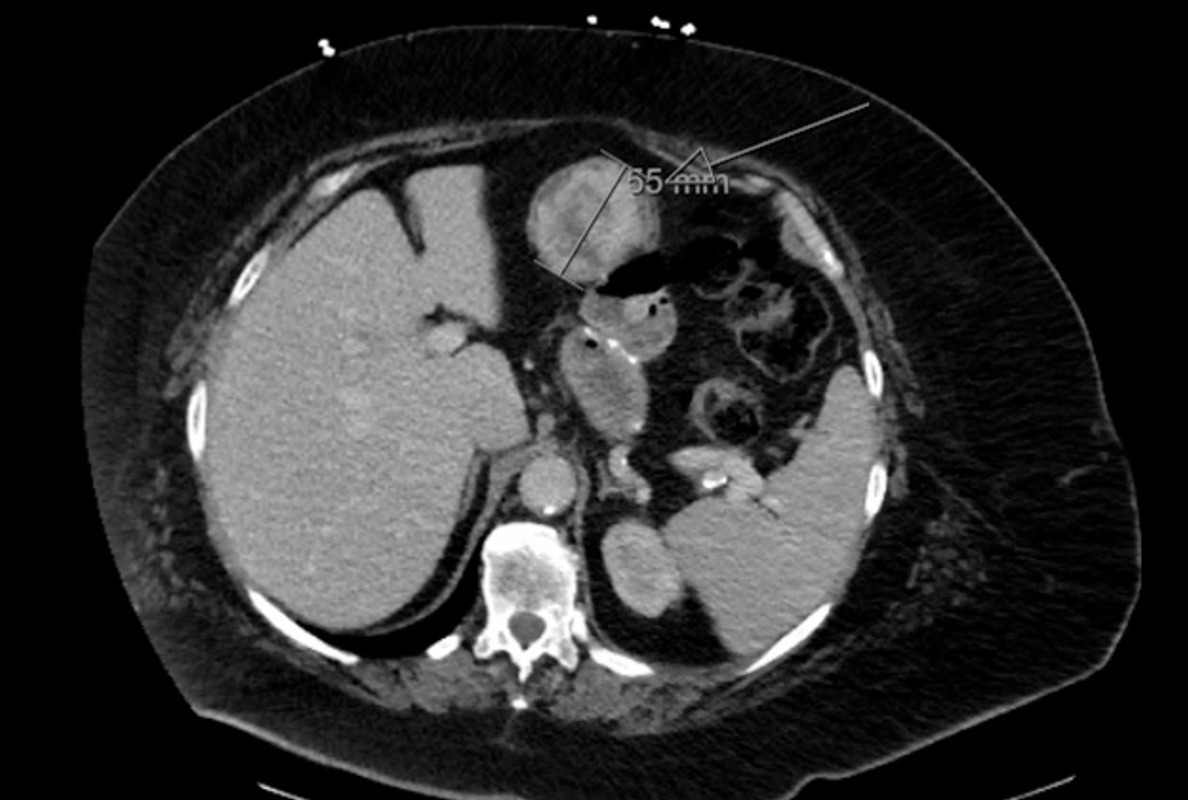Tuesday Poster Session
Category: GI Bleeding
P3489 - Exploring the Excluded Pouch: A Case Report of Neoplasm of the Excluded Gastric Pouch After Roux-en-Y Gastric Bypass Surgery Causing Gastrointestinal Blood Loss and Anemia
Tuesday, October 24, 2023
10:30 AM - 4:00 PM PT
Location: Exhibit Hall

Has Audio

Pearl Aggarwal, MD
University Hospitals St. John Medical Center
Westlake, OH
Presenting Author(s)
Pearl Aggarwal, MD, Brian Putka, MD, Sapna Thomas, MD
University Hospitals St. John Medical Center, Westlake, OH
Introduction: For patients after a Roux-en-Y surgery presenting with Gastrointestinal (GI) signs and symptoms, evaluation of the underlying cause is challenging. We present a case demonstrating neoplasm of the excluded gastric pouch causing gastrointestinal blood loss and anemia.
Case Description/Methods: A 68-year-old female with a history of Roux-en-Y and iron deficiency anemia requiring multiple iron and blood transfusions was admitted for melena and recurrent anemia. Multiple prior EGD, colonoscopy, and capsule endoscopy did not identify any bleeding source. Computed tomography of the abdomen with contrast showed a 5cm heterogenous mass in the excluded stomach—failed attempts at single balloon enteroscopy to take a biopsy. The patient subsequently underwent exploratory laparotomy and resection of the remnant stomach. Intraoperative findings were significant for an 8x5cm round submucosal mass with central ulceration in the body of the excluded stomach. Pathology suggested a low-grade Gastrointestinal stromal tumor, that is, GIST(pT3, pN0) with margins negative for cancer. Signs and symptoms resolved, and the patient was discharged with regular follow-up recommendations.
Discussion: The diagnostic approach for any overt or occult acute blood loss with or without iron deficiency anemia includes evaluating a GI source of blood loss. Gastric neoplasms in the exclusion pouch in patients with RGYB are rare. The altered anatomy in patients with RGBY poses diagnostic challenges. Available diagnostic options for excluded pouch exploration include balloon enteroscopy, percutaneous endoscopy, virtual gastroduodenoscopy, laparoscopic transgastric endoscopy, EUS, and invasive procedures like exploratory laparotomy. Literature review suggests that the risks of routine gastrectomy of the excluded pouch during the RGYB outweigh the benefits; however, if strong risk factors like family history of gastric malignancy, smoking, H Pylori infection, morbid obesity, familial disorders, it can be considered on a case-by-case basis.
In conclusion, it is essential to be aware of the possible pathologies, including the involvement of the excluded pouch and other complications of RGYB itself, to prompt diagnosis and timely management. Further studies are prudent regarding post-operative endoscopic surveillance.

Disclosures:
Pearl Aggarwal, MD, Brian Putka, MD, Sapna Thomas, MD. P3489 - Exploring the Excluded Pouch: A Case Report of Neoplasm of the Excluded Gastric Pouch After Roux-en-Y Gastric Bypass Surgery Causing Gastrointestinal Blood Loss and Anemia, ACG 2023 Annual Scientific Meeting Abstracts. Vancouver, BC, Canada: American College of Gastroenterology.
University Hospitals St. John Medical Center, Westlake, OH
Introduction: For patients after a Roux-en-Y surgery presenting with Gastrointestinal (GI) signs and symptoms, evaluation of the underlying cause is challenging. We present a case demonstrating neoplasm of the excluded gastric pouch causing gastrointestinal blood loss and anemia.
Case Description/Methods: A 68-year-old female with a history of Roux-en-Y and iron deficiency anemia requiring multiple iron and blood transfusions was admitted for melena and recurrent anemia. Multiple prior EGD, colonoscopy, and capsule endoscopy did not identify any bleeding source. Computed tomography of the abdomen with contrast showed a 5cm heterogenous mass in the excluded stomach—failed attempts at single balloon enteroscopy to take a biopsy. The patient subsequently underwent exploratory laparotomy and resection of the remnant stomach. Intraoperative findings were significant for an 8x5cm round submucosal mass with central ulceration in the body of the excluded stomach. Pathology suggested a low-grade Gastrointestinal stromal tumor, that is, GIST(pT3, pN0) with margins negative for cancer. Signs and symptoms resolved, and the patient was discharged with regular follow-up recommendations.
Discussion: The diagnostic approach for any overt or occult acute blood loss with or without iron deficiency anemia includes evaluating a GI source of blood loss. Gastric neoplasms in the exclusion pouch in patients with RGYB are rare. The altered anatomy in patients with RGBY poses diagnostic challenges. Available diagnostic options for excluded pouch exploration include balloon enteroscopy, percutaneous endoscopy, virtual gastroduodenoscopy, laparoscopic transgastric endoscopy, EUS, and invasive procedures like exploratory laparotomy. Literature review suggests that the risks of routine gastrectomy of the excluded pouch during the RGYB outweigh the benefits; however, if strong risk factors like family history of gastric malignancy, smoking, H Pylori infection, morbid obesity, familial disorders, it can be considered on a case-by-case basis.
In conclusion, it is essential to be aware of the possible pathologies, including the involvement of the excluded pouch and other complications of RGYB itself, to prompt diagnosis and timely management. Further studies are prudent regarding post-operative endoscopic surveillance.

Figure: Image 1: Computed tomography of the abdomen and pelvis with IV contrast showing a rounded heterogenous mildly hyperattenuating mass-like lesion within the excluded portion of the stomach measuring approximately 5cm (arrow) in the craniocaudal dimension.
Disclosures:
Pearl Aggarwal indicated no relevant financial relationships.
Brian Putka indicated no relevant financial relationships.
Sapna Thomas indicated no relevant financial relationships.
Pearl Aggarwal, MD, Brian Putka, MD, Sapna Thomas, MD. P3489 - Exploring the Excluded Pouch: A Case Report of Neoplasm of the Excluded Gastric Pouch After Roux-en-Y Gastric Bypass Surgery Causing Gastrointestinal Blood Loss and Anemia, ACG 2023 Annual Scientific Meeting Abstracts. Vancouver, BC, Canada: American College of Gastroenterology.
